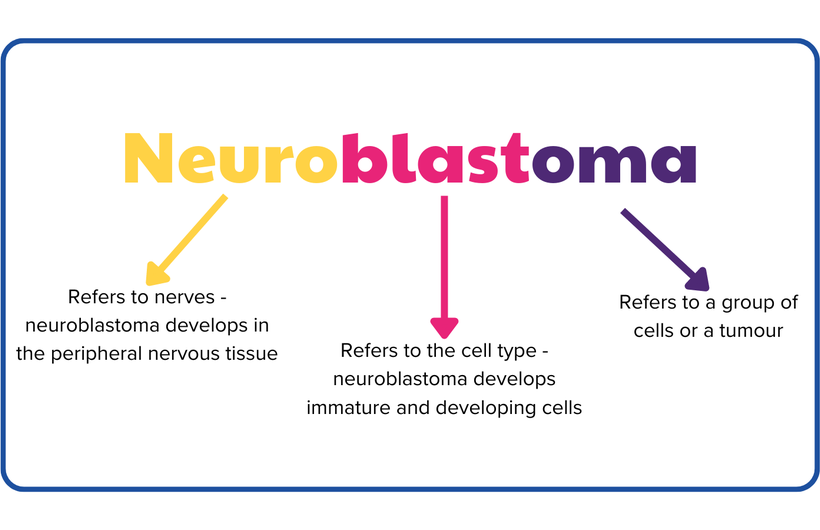What is neuroblastoma?
Neuroblastoma is a rare type of childhood cancer. It develops from a very early type of nerve cell, which is left over from development in the womb. These cells are called neuroblasts.
The term neuroblastoma describes this. ‘Neuro’ refers to nerves, ‘blast’ refers to the immature cells it develops from, and ‘oma’ refers to a group of cells or tumour.
Where does neuroblastoma occur?
Neuroblastoma can occur anywhere in the body. Tumours normally start in the abdomen (tummy) or sympathetic chain (nerve tissue that runs alongside the spinal cord), particularly in the adrenal glands. In some cases, neuroblastoma can spread to other areas in the body such as the bone marrow, bone, lymph nodes and skin.
What causes neuroblastoma?
We do not yet understand why children get neuroblastoma.
We know that neuroblastoma is not caused by environmental damage, and very few cases can be linked to an inherited predisposition. Instead, it is likely that neuroblastoma is the result of something going wrong during development, which causes neuroblastoma to grow and divide uncontrollably.
Information video on high-risk neuroblastoma
The animation below has been developed as part of the SIOPEN High-Risk Neuroblastoma 2 trial to help parents and patients understand more about high-risk neuroblastoma.
Information resource for parents and carers
The Children's & Young People's Cancer Association (CCLG) has produced a guide to help parents and carers following their child’s diagnosis. It provides specific information about neuroblastoma, its treatment, and possible side effects. This guide has been written with the help of experts and parents and offers a general overview of neuroblastoma. It will also act as a helpful reminder for any discussions you have with your child’s treatment team. Click here to download the guide or to order a free physical copy.
Symptoms of neuroblastoma
Because neuroblastoma often occurs in the adrenal glands or abdomen, a common symptom is a lump in the child's tummy, causing it to be painful and swell. Neuroblastoma may also appear as a lump in the neck.
Other neuroblastoma symptoms
- A fever
- Pain in joints or bones
- A limp (difficulty walking)
- Tiredness/weakness
- Lack of appetite/weight loss
- Sweating
- Bruising
- Constipation
- Blue lumps under the skin
The symptoms of neuroblastoma and other childhood cancers are often vague and are associated with much more common illnesses. This means it can be difficult for children to be diagnosed, and it is common for the neuroblastoma to have developed significantly before it is diagnosed by a doctor.
What should I do if I am worried my child has neuroblastoma?
If your child has any of these symptoms and you are worried, see your GP, they may refer your child to a specialist for diagnosis. Having these symptoms does not mean your child has neuroblastoma.
Diagnosis
Your GP should refer your child to a specialist if they show the more common symptoms of neuroblastoma, like a lump in their tummy or a swollen tummy.
You will see a specialist children's doctor, called a paediatrician. Depending on your child's symptoms, you may also see a paediatric oncologist - a specialist children and young person's cancer doctor.
What tests are carried out to check for neuroblastoma?
If one of these doctors suspects that your child may have neuroblastoma there will be several tests that will need to be done to confirm a diagnosis and help determine the best way to treat them.
Some common tests include:
- Urine tests - to check for certain substances that are produced by the neuroblastoma.
- CT, MRI, and ultrasound scans - to produce images of areas inside the body where there may be tumours.
- MIBG (metiodobenzyl guanidine) scan - an injection of a radioactive molecule which attaches to neuroblastoma cells to make them visible in scans.
- Biopsy - a small sample of cells, taken using a needle, that are examined under a microscope.
- Bone marrow biopsy - samples taken of bone marrow to check if the neuroblastoma has spread to the bones.
- X-ray scans - to look for abnormalities in the bones.
Your child may have more than one test on the same day, and these tests will continue throughout treatment and beyond if they are diagnosed with neuroblastoma.
Some scans may need to be carried out under general anaesthetic depending on the type of scan, and age of your child. This is because your child may need to be very still for a long period of time.
What should I expect after diagnosis?
When families receive a diagnosis of neuroblastoma, they can often experience confusion, shock, and bewilderment. These are all normal reactions.
It is important to remember that it is not your fault your child has cancer and is not the result of anything you have or have not done. It is likely that you have never heard the word ‘neuroblastoma’ before and may not have even realised that children can get cancer.
In the days around diagnosis, you may have met new specialists, doctors, nurses, and support staff. They are experienced and will understand that families may need some time to absorb what has happened. Nobody is expected to understand complicated cancer treatments straight away and health professionals are very used to having to repeat themselves and rephrase things in a way that helps parents to understand. It is very common to find it difficult to take in and remember information for a length of time after diagnosis.
Where can I go for help?
If your child has recently been diagnosed with cancer and you need support, our Family Support Service can help. Our team are parents with lived-experience of neuroblastoma, so truly understand what you are going through and know how to help. Use the contact form below to get in touch, or call 0207 284 0800 or email support@solvingkidscancer.org.uk.
We also have a range of resources available for newly diagnosed families which can be found in our Support Hub.
Staging and risk groups
At diagnosis, you will be told what ‘stage’ and what ‘risk group’ of neuroblastoma your child has.
Neuroblastoma varies from case to case, and this means that the outlook is unique to a child’s particular circumstances. Similarly, the treatment pathway for neuroblastoma is not the same for every child, and it is common to find that they will not follow what is considered the ‘typical’ journey.
Read more on risk groups and staging in the drop-down below.
-
-
There are different 'stages' of neuroblastoma which describe how far it has grown and spread, and clinicians use this to decide the best treatment path for each child.
Stage 1 (INRG stage L1): The cancer is localised and has not spread. It can be completely or almost completely removed by surgery.
Stage 2 (INRG stage L1): The cancer is localised and has not spread, but it cannot be completely removed by surgery. This is often due to the position of the tumour meaning total tumour removal would cause damage to organs or major blood vessels.
Stage 3 (INRG stage L2): The tumour has begun to spread to nearby lymph nodes but not distant parts of the body.
Stage 4 (INRG stage M): This is when the tumour has spread to distant parts of the body. This stage is usually designated as 'high-risk' and will usually be treated with chemotherapy, surgery, radiation, stem-cell transplant, and immunotherapy. Around half of children have disease that has already spread by the time of diagnosis, so whilst it may be alarming to be diagnosed at Stage 4, this is not uncommon due to the nature of neuroblastoma which makes it difficult to spot.
Stage 4s (INRG stage MS): This is a stage unique to this type of childhood cancer and does not occur in children over 18 months old. It refers to a type of the disease that presents as a primary tumour and may have spread to local lymph nodes, but only on one side of the body. There will be no spread to the bones and less than 10% of bone marrow cells will be neuroblastoma. This type of disease has been known to spontaneously regress into a benign state and so often the only course of action will be to maintain close observation of the child to ensure nothing changes.
-
As well as defining the stage of the cancer, your child will also be given a risk group which mostly relates to their risk of the cancer coming back and how far it has spread. It also determines the treatment they will receive. Risk groups are related to stages, but there is not a complete overlap.
Low-risk neuroblastoma: This normally applies to stage 1 (INRG stage L1) patients, and most stage 2 (INRG stage L1) patients who are less than 12 months old and/or have no unfavourable genetic mutations.
Intermediate-risk neuroblastoma: This usually includes stage 3 (INRG stage L2) and 4 (INRG stage M) patients, who are less than 12 months old and have no unfavourable features in the genes of their tumour.
High-risk neuroblastoma: This usually includes stages 2 (INRG stage L1), 3 (INRG stage L2), and 4 (INRG stage M) where the patient is older than 12 months and/ or has unfavourable features in the genes of their tumour.
-
Treatment for neuroblastoma
The treatment your child will receive for neuroblastoma depends on many factors including the stage and risk-group of the cancer, the location of the cancer, and your child’s age.
Because neuroblastoma is a very variable disease, treatment pathways for one child compared to another can look very different. Your doctor will follow the best plan for your child given their individual circumstances.
Common neuroblastoma treatments
- Surgery
- Induction chemotherapy
- High-dose chemotherapy
- Stem cell transplant
- Radiotherapy
- Immunotherapy
This information is PIF TICK accredited which means it has been produced with robust guidelines that make sure it is accurate and trustworthy.
Resource production date: 04/05/2021
Last Reviewed: 29/03/2023
Next Review: 15/03/2026
 Read more about the PIF TICK
Read more about the PIF TICK





